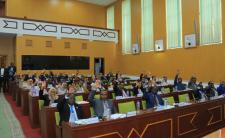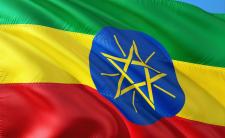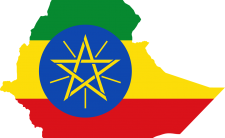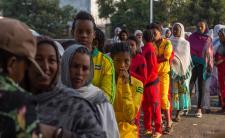Constitutional history
Ethiopia is the oldest independent country in Africa and one of the oldest independent countries in the world. During the late nineteenth and twentieth centuries, Emperor Menelik II created the current Ethiopian state through expansion and conquest. This process created a state with over eighty ethnic groups who speak over seventy languages. Menelik consolidated his reign and maintained his empire through force. During his reign, Menelik signed a treaty with Italy in 1890, proclaiming Eritrea an Italian colony. Upon his death in 1913, Haile Selassie became emperor after a brief period of struggle. Selassie established a modern administrative state, but did not completely abolish the feudal system as his reign largely depended on the system. In 1936, the Italians ousted Emperor Selassie from power. Five years later, British and Ethiopian forces defeated the Italians, and Emperor Selassie returned to his throne. With the exception of the five years under Italian control (1936-1941), Ethiopia remains one of the few African countries not colonized by a European power.
In 1952, the United Nations created a federation between Ethiopia and Eritrea under two different governments. In 1962, Ethiopia annexed Eritrea, sparking an independence struggle which lasted for 30 years.
Emperor Selassie ruled Ethiopia until 1974 when civil unrest broke out. The Derg, led by Lt. Col. Mengistu, staged a Marxist coup, which overthrew Emperor Selassie and installed a socialist military government. Mengistu, financed by the Soviet Union, implemented a totalitarian-style government and a massive militarization of the country. From 1977-1979, the Derg tortured or killed thousands of suspected enemies in what was known as the “Red Terror”. Having effectively silenced all opposition, the Derg officially adopted a communist constitution in 1987.
Due to the Derg's oppressive regime, rebel groups led by the Tigrayan Peoples' Liberation Front (TPLF) and the Ethiopian Peoples' Revolutionary Democratic Front (EPRDF) merged to overthrow Mengistu in 1991. A series of famines and insurrections in the Tigray region and Eritrea also contributed to the Derg's collapse. Eritrea declared its independence from Ethiopia one week after the defeat of the Derg.
The EPRDF and the Oromo Liberation Front (OLF) formed the Transitional Government of Ethiopia (TGE) in 1991. Following the 1992 elections, the TGE created a Constitutional Commission to draft a new charter. On December 8, 1994, the 547-member constituent assembly adopted the current constitution, establishing the Federal Democratic Republic of Ethiopia.
Modern constitutional history
Ethiopia's 1994 constitution is a direct result of the government pursuing a policy of “ethnic democracy.” Ethnicity serves as the foundation for Ethiopia's political parties and is what motivates the Constitution's two-tiered federal system. In addition to the central government, there are nine regional states whose borders roughly trace ethnic lines. The constitutional structure cemented ethnicity as the definitive issue in Ethiopian politics.
The first elections under the 1994 constitution were held in May and June of 1995. Most opposition parties to the EPRDF boycotted the elections because they were excluded from the constitutional process. During the transitional period, the EPRDF gained power through intimidation and force. Given the non-participation of many opposition parties in the 1995 elections, the EPRDF won the majority of the electoral contests.
In 1998, the Eritrean army invaded Ethiopia, sparking a two-year war between the states that resulted in over 100,000 deaths. The two countries signed an Agreement on Cessation of Hostilities on June 18, 2000 and a peace agreement on December 12, 2000. The United Nations deployed a peacekeeping force to maintain compliance with the agreements. Despite the peace treaty, tension remains between the two countries.
Elections were held again in 2000-2001. The EPRDF officially allowed opposition parties to participate, but because of the national police's intimidation, many opposition candidates decided not to run. In the end, opposition candidates only won 12 of the 547 seats in parliament. International observers did not deem the elections free or fair.
The 2005 elections were the most free and fair in Ethiopia's history. Voter turnout was approximately 80 to 90 percent and multiple parties were on the ballot. However, because of irregularities and contestation, the final results were not released until September. According to the official results, the EPRDF remained in control, winning 67.85 percent of the vote and 371 seats in parliament. Despite the opposition parties' significant gains, they still remained dissatisfied because of voting irregularities. When the EFRDF refused to perform a recount, the opposition responded with public protests. In the name of maintaining public order, the ruling party responded in November 2005 by killing 40-50 people and wounding hundreds of others. The government proceeded to arrest thousands of opposition leaders, journalists, and human rights advocates. By mid-January 2006, 11,200 people were released, but the majority was still held in detention camps. As of March 2008, one hundred and fifty of the elected opposition leaders had taken their seats in parliament, but the opposition and majority remained at a stalemate. During the local elections in April 2008, government intimidation made it difficult for opposition candidates to run for office.
Recent constitutional building process
The Derg pursued a policy of Ethiopian nationalism, which often led to human rights abuses against ethnic groups who did not support the Derg's centralization of power. The 1994 Constitution reflected both a backlash against the Derg's ethnic violence and Ethiopia's multitude of ethnic groups. Ethiopia adopted a constitution that creates a two-tiered federal structure, which, at least in principle, emphasized ethnic groups' rights and the right to self-determination.
The EPRDF captured the capital, Addis Ababa, on May 28, 1991. In July, a national conference was held, which included representatives from over 20 ethnic and regional groups. Two groups were not invited – the Workers Party of Ethiopia, which disintegrated after the fall of the Derg, and non-ethnic political parties which had united in exile. Despite the exclusion of those groups, the diverse representation suggested that the EPRDF was at first willing to allow broad participation in the constitutional process. However, the EPRDF remained in charge of the conference and kept participation and the agenda under its control. The conference adopted a Transitional Charter pending the adoption of the Constitution. The Charter established an 87-member council, of which the EPRDF held 32 seats. Initially, most groups supported the transition because of the apparent commitment to pluralism.
Led by the EPRDF, the National Conference decided to build a political system based on ethnicity, which shaped Ethiopian politics and the constitution-building process. In January 1992, the Council divided the country into 12 regions, roughly along ethnic lines. This decision reinforced ethnicity as the guiding force behind Ethiopian politics and campaign issues.
During late 1991 and early 1992, strife between the EPRDF and OLF nearly ended the transitional process. Political disagreements within the Council led to military infighting, which pushed the country to the brink of civil war. Each party wanted control over certain key areas of the country in anticipation of the upcoming elections. Peace talks led by the Provisional Government of Eritrea and the United States ended in a cease-fire. This peace allowed for the scheduling of elections in June 1992. By this point, the EPRDF, with its military prowess and favorable governing rules, had control over most of the country.
On June 21, 1992, regional and local elections were held for the TGE. However, they did not take place in an environment where true political competition could occur. The OLF and other major political parties asked for a postponement of the elections, but after the request was denied, they withdrew from the ballot. Consequently, only the EPRDF and its allies appeared on the election ballot in many areas. As a result, the EPRDF won 1,108 of the 1,147 assembly seats.
The transitional government created a Constitutional Drafting Commission. Public forums were held in Ethiopia and abroad to discuss the opinions of civic organizations and political parties. However, many of the EPRDF's opposition groups felt that they could not participate fully unless they agreed with the EPRDF. These groups tried to build coalitions to counter the EPRDF, but without much success. In March 1993, some opposition members held a meeting in Paris, including some members of the Council formed after the 1992 elections. Because of their participation in the meeting, the EPRDF expelled these groups from the TGE.
In December 1993, the opposition tried again to alter the transition process by holding a meeting in Addis Ababa called the “Peace and Reconciliation Conference.” The TGE boycotted the meeting and arrested its leaders who attempted to participate. The opposition appealed to the United States in the hope that the TGE could participate in the formation of a new transitional government that would be more inclusive of other political parties. The opposition met with former President Jimmy Carter in February 1994, but the strategy failed when the transitional government declined President Carter's offer to mediate. Consequently, support for the TGE's framework dropped and the opposition became more marginalized.
On June 5, 1994, elections were held to elect a Constituent Assembly for the purpose of reforming the constitution. After all the talks failed, the major opposition parties did not participate in the elections. As a result, the EPRDF won 484 of the 547 seats in the Constituent Assembly. Without any major opposition, the Constituent Assembly ratified the constitution on December 8, 1994.
As noted above, the Ethiopian constitution creates a two-tiered federal structure. The Executive Branch consists of the President, Council of State, and the Prime Minister. The Prime Minister maintains the executive power. The Constitution creates a bicameral parliamentary system consisting of the House of People's Representatives and the House of Federation. Electoral districts elect representatives for the House of People's Representatives every five years. The House of Federation consists of at least one representative from each “Nation, Nationality and People.” The House of People's Representatives decides issues related national infrastructure, nationality, war, and federal statutes. The House of Federation maintains control of issues related to states' rights, including “the right to secession.”
There are also nine states within Ethiopia, which are drawn along ethnic lines. Each state maintains its own legislative, executive, and judicial branches. The State Council is the highest authority in each state, and it has the authority to amend the state constitution. Each state is subdivided into smaller local governments. The Constitution calls for each State Council to decentralize the administration to the local authorities.
Timeline
| 1889 |
Emperor Menelik accedes to the throne and creates Ethiopia within its modern borders with Addis Ababa as the capital. |
| 1889 |
Menelik signs a bilateral friendship treaty with Italy, which Italy interprets as giving it a protectorate over Ethiopia. Ethiopia then rejects the treaty. |
| 1896 |
Italy attacks Ethiopia. Ethiopia defeats Italy. Italy recognizes Ethiopia's independence, but maintains control over Eritrea. |
| 1930 |
Emperor Selassie accedes to the throne. |
| 1935 |
Italy invades Ethiopia. |
| 1941 |
British and Ethiopia forces defeat the Italians; Emperor Selassie returns to the throne. |
| 1952 |
The United Nations federates Eritrea with Ethiopia. |
| 1962 |
Emperor Selassie annexes Eritrea. Eritrean independence struggle intensifies over the next thirty years. |
| 1973-1974 |
Approximately 200,000 people die as a result of famine. |
| 1974 |
The Derg overthrows Emperor Selassie in a coup. |
| 1977 |
Colonel Mengistu assumes power. |
| 1977-1979 |
Thousands die in the “Red Terror” led by Mengistu. |
| 1984-1985 |
Worst famine in decades occurs. |
| 1987 |
Derg communist constitution adopted; Mengistu elected president. |
| 1991 May 28 |
EPRDF captures Addis Ababa and defeats Mengistu regime. |
| 1992 June 21 |
Regional and local elections are held for transitional government. |
| 1993 March |
Opposition party meeting in Paris. |
| 1993 May |
Ethiopia recognizes Eritrea as an independent state. |
| 1993 December |
Peace and reconciliation conference organized by opposition. |
| 1994 February |
Opposition meets with former President Jimmy Carter. |
| 1994 June 5 |
Elections for Constituent Assembly held. |
| 1994 December 8 |
Present-day constitution is adopted. President Meles Zenawi becomes Prime Minister. |
| 1998-2000 |
War ensues between Ethiopia and Eritrea. |
| 2000 May |
Parliamentary elections held. They result in EPRDF victory. |
| 2005 May 15 |
Protests ensue over alleged voting irregularities. 40 people are shot. |
| 2005 August-September |
Election re-runs for over 30 seats. Officials claim that the ruling party has sufficient seats to form the government. |
| 2005 November |
Protests over May election results take place. The government detains thousands of opposition members and journalists. 46 protesters die. |
| 2006-2007 |
Tensions heighten between Ethiopia and Somalia. Ethiopia claims it was battling the Islamic militia in Somalia. Eritrea is accused of supplying arms to Islamist administration. |
| 2007 June |
Opposition leaders are given life sentences for 2005 election protests, but are later pardoned. |
| 2008 June |
Peace agreement between Ethiopia and Somalia is signed. |
| 2008 July |
United Nations votes to end peacekeeping mission monitoring border between Ethiopia and Eritrea. |
| 2008 December |
Government re-arrests key opposition leaders involved in 2005 protests. |
| 2009 January |
Parliament passes bill, which bans foreign agencies involved in human rights or conflict resolution work as a means of restricting foreign involvement. |
| 2009 January |
Ethiopia withdraws all of its troops from Somalia. |
| Branch | Hierarchy | Powers | Removal |
|---|





